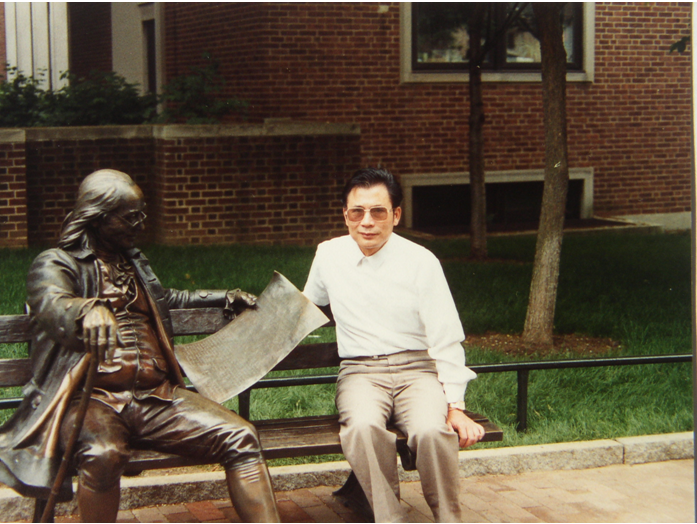我钟情于陶渊明笔下的菊花
我钟情于陶渊明笔下的菊花
Tu Xiang Zheng (涂向真)
菊花是中国十大名花之一,被誉为“花中四君子”之一。菊花在秋季盛开,象征着丰收的秋天,因此人们将九月称为“菊月”。诗人陶渊明对菊花情有独钟,他的《饮酒》一诗赋予了菊花“花中隐士”的美誉,广为传诵。陶渊明在《饮酒》中写道:
结庐在人境,而无车马喧。
问君何能尔?心远地自偏。
采菊东篱下,悠然见南山。
山气日夕佳,飞鸟相与还。
此中有真意,欲辩已忘言。
关于诗中“南山”的含义,历来解释众多,但广为认可的是指庐山,这也与陶渊明的故居相关。他是浔阳柴桑(今江西九江西南)人,而浔阳城南正有著名的庐山。我故乡在南昌市新建区,与庐山同处鄱阳湖之滨,因此我对这种说法尤为赞同。
在美国,菊花也触动了诗人们的情怀。十九世纪的诗人伊丽莎白·艾克斯·艾伦在其诗作《菊花》("Chrysanthemums")中,深情地表达了对自然瞬息之美与人类情感之间联系的思考。艾伦擅长将爱、失落和时间流逝等主题融入生动的自然意象中。在这首诗里,菊花象征秋日的辉煌与季节的必然更替。诗人沉思着菊花的精致之美,将它们的生机与对生命无常的忧思并列。艾伦的抒情风格和对感官细节的细腻描绘,让读者在欣赏这短暂之美的同时,也触发内心深处对生命流逝的共鸣。
《菊花》
伊丽莎白·埃克斯·艾伦
很久以前,在夏日的暖阳中,
我们,你和我,
穿梭在花园的迷宫中,
它的美丽令人着迷,——
紫罗兰甜美地弯下腰,
石竹骄傲地挺立着。
从它们嫩绿的屏风中
探出头来,
宽大的三色堇,
像蝴蝶一样披着华丽的色彩;
清凉的百合花沾满露水,
攀缘的玫瑰花美丽而高大地生长着。
丝绒蜜蜂在芬芳中安逸,
陶醉在香气中,
歌雀把花园的树荫变成了
它们合适的音乐厅,
那里的空气都是音乐,
整个大地都盛开着鲜花。
那里长着一株植物,
完全缺乏花蕾或花朵; —
我折断一枝树叶,
说道:“冬天
会给这些枝干戴上冠冕,
这枝干上开着基督的甜美花朵。
”它绽放,使
寒冷的十二月滋养的
暴风雨般的阴霾变得欢快;
古老的故事里讲到,
这美丽的花朵
首先在基督诞生的那个神圣的早晨绽放,
绽放成洁白的美丽。
“也许——啊,好吧,我们无法说清
是否真的如此;
我只是重复这个甜美的传说,
而我只知道——
在圣诞节的黄金时期,
基督的甜美花朵绽放。
“比这里的任何地方都更纯净、更清澈,
它们的雪白圆盘展开,
白得像一颗融化在远处的星星
融入早晨的金色,
气味无与伦比,
它们的芳香边缘持久。
“我为了纪念而折断这根树枝,
在雪花飘落之前,
我砍下的细枝
将在我们的家中生长;
那里多么明亮,洁白而美丽,
基督的甜美花朵将绽放!”
窗帘遮住了寒冷,——
凄冷的雪花飘落;
红色的火光落在墙上
美丽的图画闪闪发光;
在灯光下,基督的甜美花朵绽放出美丽和洁白。
但冰冷而深沉的雪堆
覆盖在你沉默的身躯之上;
我无法将我的衣褶
挡在你和暴风雨之间,——
我不敢忍受刺骨的寒风,
紧紧地抱住你,让你暖和起来。
而对我来说,什么是轻松和欢乐
而我一直知道
那寒冷而深沉的雪堆
低低地覆盖在你的睡眠之上,
我又何必在乎那洁白而美丽的
基督的甜美花朵的绽放?
《Chrysanthemums》
Once, long ago in summer's glow,
We threaded, you and I,
A garden's maze of pleasant ways,
Whose beauty charmed the eye, —
Where violets bent in sweet content,
And pinks stood proud and high.
And from their screen of tender green
Broad pansies, peeping through,
Wore gorgeous dyes like butterflies;
Cool lilies kept the dew,
And fair and tall along the wall
The climbing roses grew.
The velvet bees in fragrant ease,
Lay drunken with perfume,
Song-sparrows made the garden's shade
Their fitting concert-room,
And all the air was music there,
And all the earth was bloom.
There grew one plant in utter want
Of bud or blossom-dower; —
I broke a spray of leaves away,
And said, " The winter hour
Will crown these stems with diadems, —
This bears the Christ's sweet flower.
" It cheers with bloom the stormy gloom
By chill December nursed;
And it is told in stories old
That this fair blossom first,
On that blest morn when Christ was born,
Into white beauty burst.
" Perhaps — ah well, we cannot tell
If truly it be so;
I but repeat the legend sweet,
And only this I know, —
That in the prime of Christmas time
The Christ's sweet flowers blow.
" More pure and clear than any here,
Their snowy discs unfold,
White as a star that melts afar
Into the morning's gold,
And odor rare above compare,
Their fragrant fringes hold.
" This branch I break for memory's sake,
And ere descends the snow,
The slender bough I sever now
Within our home shall grow;
How brightly there, all white and fair,
The Christ's sweet flowers shall blow! "
The curtains fold away the cold, —
The bleak and drifting snow;
Red fire-gleams fall where on the wall
The pleasant pictures glow;
And fair and white beneath the light
The Christ's sweet flowers blow.
But cold and deep the snow-drifts heap
Above thy silent form;
I cannot hold my garment's fold
Between thee and the storm, —
I cannot dare the bitter air,
And clasp thee near and warm.
And what to me are light and glee
When all the while I know
That cold and deep the snow-drifts heap
Above thy slumber low,
What do I care that white and fair
The Christ's sweet flowers blow?
